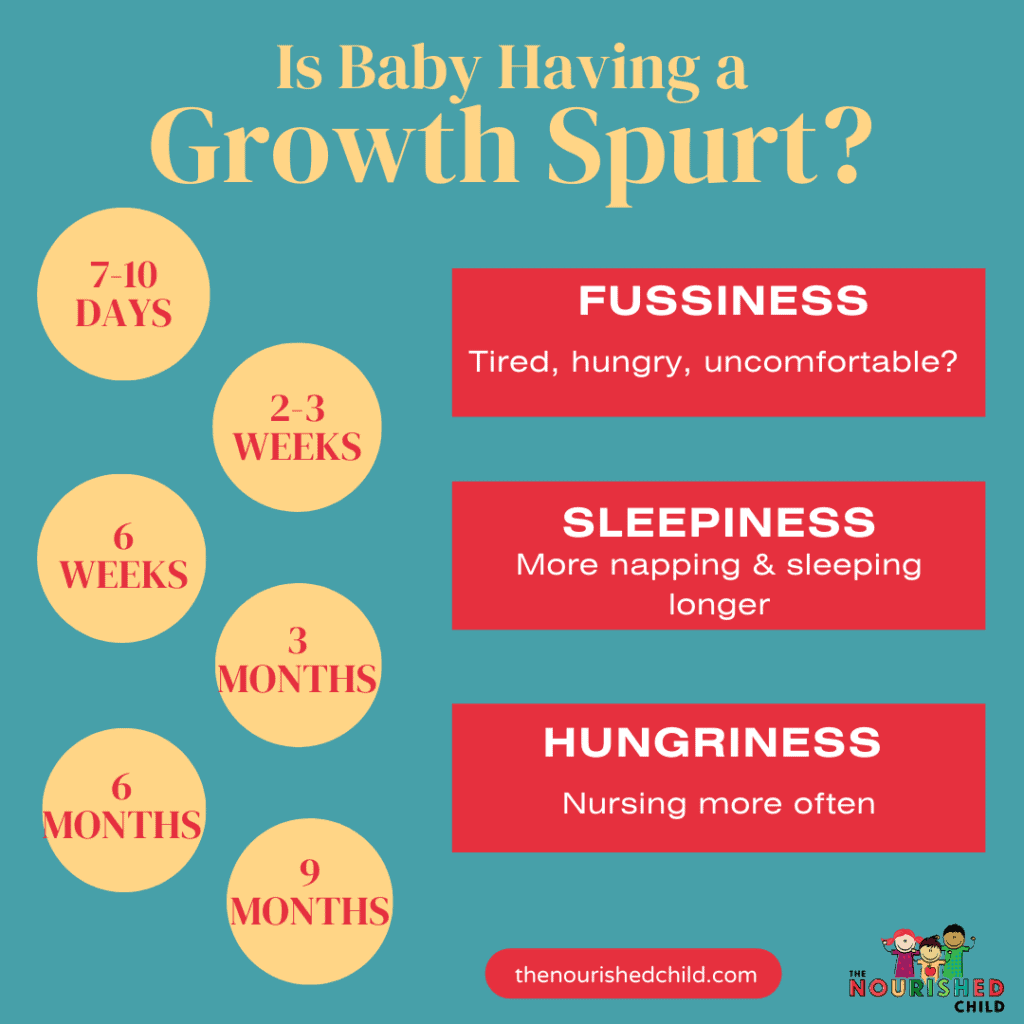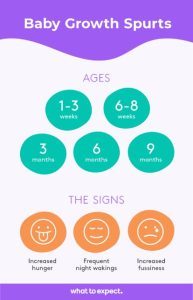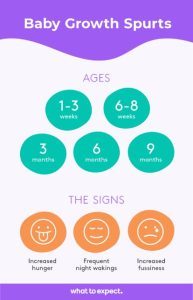Babies have growth spurts around 7-14 days, 3 weeks, 6 weeks, 3 months, and 6 months. These spurts may lead to increased feeding and fussiness.
Babies undergo rapid physical and developmental changes during certain periods, known as growth spurts. These phases are typically observed at around 7-14 days, 3 weeks, 6 weeks, 3 months, and 6 months. During these spurts, babies may require more frequent feeding and exhibit increased fussiness, which can be distressing for parents.
Understanding when these growth spurts occur can help caregivers prepare for the changes in their baby’s behavior and nutritional needs. We will delve deeper into the signs of growth spurts, how long they typically last, and how parents can provide support and care during these critical developmental periods.
Newborn Stage
During the newborn stage, babies develop at a rapid pace, experiencing significant growth spurts that are essential for their overall development. Understanding the growth patterns and key milestones during this stage can help parents and caregivers provide the best support for their baby’s growth and development.
Initial Growth Patterns, Babies have growth spurts
Babies experience rapid growth during the first few weeks of life, with significant changes in their weight, length, and head circumference. In the initial days, it is common for babies to lose a small amount of weight, mainly due to fluid loss. However, they typically regain their birth weight by around 2 weeks of age. After this initial fluctuation, babies start to gain weight steadily, and their growth patterns become more consistent.
Key Milestones In The First Few Weeks
- During the first two weeks, babies may exhibit signs of rapid growth, including increased appetite and more frequent feedings.
- By the end of the first month, babies may have gained about 1.5 to 2 pounds from their birth weight.
- Babies’ head circumference also undergoes significant changes during the newborn stage, with their head growing to accommodate brain development and overall growth.
- Physical activities and movements may also show signs of progression, with babies exhibiting more controlled head movements and increased alertness.
Infancy Period
Welcome to the wonderful world of infancy, where growth and development are at their peak. The first year of a baby’s life is full of exciting milestones and rapid changes. One of the fascinating aspects of this period is the occurrence of growth spurts. These are phases in which babies experience a sudden burst of growth in terms of both height and weight. Understanding when these growth spurts are likely to happen and the factors that influence them can be helpful for parents in providing the best care for their little ones.
Typical Growth Spurts In The First Year
During the first year, babies go through several growth spurts that are usually predictable. These spurts happen at specific intervals and are generally accompanied by changes in appetite, sleep patterns, and behavior. While every baby is unique and may experience growth spurts at slightly different times, the typical growth spurts in the first year can be observed around:
| Age | Months |
|---|---|
| 1 | 2 weeks |
| 2 | 4 weeks |
| 3 | 6 weeks |
| 4 | 3 months |
| 5 | 6 months |
| 6 | 9 months |
| 7 | 12 months |
These growth spurts are essential for a baby to achieve their milestones and thrive. It’s important to note that some babies may experience additional mini-growth spurts in between these general timeframes.
Factors Influencing Growth Spurts
Various factors can influence the timing and intensity of a baby’s growth spurts. Understanding these factors can help parents anticipate and adapt to their baby’s changing needs. Some key factors include:
- Nutrition: Adequate nutrition plays a significant role in a baby’s growth. Breast milk or formula provides essential nutrients for their development.
- Sleep: Growth spurts often coincide with disrupted sleep patterns. Babies may require more sleep during these periods to support their growth.
- Physical activity: Increased physical activity, such as crawling or walking, can trigger growth spurts as muscles and bones develop.
- Genetics: The genetics inherited from parents can influence the timing and intensity of growth spurts.
- Hormones: Hormonal changes within a baby’s body also play a part in growth spurts.
By understanding the typical growth spurts in the first year and the factors that influence them, parents can ensure they provide the necessary support and care during these crucial periods of growth and development.
Toddler Years
As babies grow and develop, they eventually transition from infancy to toddlerhood. This is an exciting and crucial stage in their lives, marked by significant milestones in physical, cognitive, and social development. During the toddler years, children start exploring the world around them with newfound independence and curiosity. It’s also a time when they experience growth spurts, both in terms of physical growth and cognitive abilities.
Transition From Infancy To Toddlerhood
When babies turn one, they officially enter the toddler stage. This period is filled with both joy and challenges for both children and parents. Toddlers begin to walk, talk, and assert their independence, making it an exciting time for parents to witness their little ones blossom into individuals with unique personalities.
By the time they reach 18 months, toddlers have usually tripled their birth weight and grown about half of their adult height. These physical growth spurts are often accompanied by changes in appetite and sleep patterns as their bodies adjust to their rapidly growing size. Therefore, as a parent, it’s crucial to ensure your toddler receives a balanced diet and enough rest.
Growth Spurts During The Toddler Stage
Growth spurts are not limited to infancy; they continue to occur during the toddler stage as well. While these spurts may not be as pronounced as during the first year, they are still significant for a child’s development. During these phases, you might notice your little one seeming hungrier or constantly reaching for that snack drawer.
Here are a few signs that your toddler may be going through a growth spurt:
- Increase in appetite: Your toddler may suddenly appear more eager to eat and may ask for snacks more frequently. This is because their growing bodies require additional nutrients to support their burgeoning physical and cognitive development.
- Disrupted sleep patterns: Growth spurts can disrupt a toddler’s sleep, causing them to wake up more frequently during the night or experience difficulty falling asleep. This is temporary and usually resolves once the growth spurt subsides.
- Rapid weight and height gain: During growth spurts, you may notice a sudden increase in your toddler’s weight and height. Their clothes may suddenly feel tighter, and they may outgrow their shoes faster than expected.
- Increase in energy levels: As toddlers go through growth spurts, they often become more active and energetic. You may notice them running around more, exploring their surroundings, and engaging in imaginative play.
It’s important to remember that growth spurts can be unpredictable, and not all children go through them at the same time or with the same intensity. However, understanding the signs of growth spurts during the toddler years can help parents provide the necessary support and ensure their child’s wellbeing.

Preschool Stage
During the preschool stage, babies experience growth spurts at various times. These spurts can occur around 6-9 months and again at 12 months, as well as during other points in the preschool years. Keep an eye out for signs of increased appetite, sleep patterns, and developmental milestones during these times.
During the preschool stage, children experience significant physical growth and developmental leaps. This period, typically spanning from ages 3 to 5, is marked by rapid changes in height, weight, and other physical developments. Preschoolers undergo specific growth patterns and experience associated growth spurts that contribute to their overall growth and development.
Physical Growth Patterns In Preschoolers
Preschoolers exhibit noticeable physical growth patterns as their bodies continue to grow and mature. These growth patterns can vary among children, but there are general trends that parents and caregivers can expect during this stage.
- Increased height: Preschoolers may experience growth spurts in height, adding several inches to their overall stature.
- Weight gain: Along with height, preschoolers also gain weight as their bodies develop. Regular exercise and a balanced diet are essential to ensure healthy growth.
- Changes in body proportions: As preschoolers grow, their body proportions also change. For instance, their torso may lengthen, and their limbs become more proportionate to their bodies.
Developmental Leaps And Associated Growth Spurts
Preschoolers not only undergo physical growth but also experience remarkable leaps in their cognitive and social-emotional development. These developmental milestones are often accompanied by growth spurts.
- Language development: During the preschool stage, children rapidly expand their vocabulary and begin to form more complex sentences. This leap in language skills is often associated with a growth spurt in brain development.
- Social skills: Preschoolers also make significant strides in their social skills. They start to understand and navigate more complex social interactions, such as sharing, taking turns, and empathizing with others.
- Motor skills: Fine and gross motor skills further improve during this stage. Preschoolers become more adept at activities like drawing, riding a tricycle, and dressing themselves.
These developmental leaps and growth spurts in the preschool stage contribute to the overall growth of children, shaping their abilities and personalities. Understanding these patterns can help parents and caregivers support their preschoolers’ development through appropriate activities, nutrition, and ample rest.
Adolescent Growth Spurts
Babies experience growth spurts during their first year, but the most dramatic growth occurs during adolescence. Let’s delve into the changes that adolescence brings.
Onset Of Puberty And Rapid Growth
Puberty typically begins around age 10-14 for girls and 12-16 for boys. During this time, their bodies undergo rapid growth as they develop secondary sexual characteristics like breast development in girls and facial hair growth in boys.
Emotional And Physical Changes During Adolescence
Emotionally, adolescents may experience mood swings and a desire for independence. Physically, their bodies develop muscle mass, their bones elongate, and they may experience acne due to hormonal changes.
:max_bytes(150000):strip_icc()/GettyImages-1330336842-81c9fad8093645728e68aef3a862ab01.jpg)
Factors Affecting Growth Spurts, Nutritional Considerations
Babies’ growth spurts can be influenced by nutritional intake, such as breast milk or formula frequency.
Genetic Factors And Individual Growth Trajectories
Each baby’s growth trajectory is unique and influenced by genetic factors inherited from parents.
Monitoring Growth
Understanding when babies have growth spurts is essential for parents to ensure their little ones are developing healthily. By monitoring growth, you can track your baby’s progress and take necessary actions if there are any concerns. Let’s explore the tools available for tracking growth spurts and the importance of consulting healthcare professionals for guidance.
Tools For Tracking Growth Spurts
Parents can utilize various tools to keep track of their baby’s growth spurts. One of the most common methods is to maintain a growth chart, where you can record your baby’s weight, length, and head circumference measurements as they grow. There are also growth tracking apps available, allowing you to input and monitor your baby’s development easily.
Consulting Healthcare Professionals For Guidance
Seeking guidance from healthcare professionals is essential when monitoring your baby’s growth spurts. Pediatricians and healthcare providers can offer expert advice regarding your baby’s growth milestones, ensuring that they are progressing as expected. Regular check-ups and consultations provide the opportunity to address any concerns and receive personalized recommendations.
In conclusion, monitoring your baby’s growth through appropriate tools and seeking professional guidance is crucial for ensuring their well-being during growth spurts.
How Do I Know If My Baby Is Having A Growth Spurt?
Babies having more frequent feedings or being fussier may indicate a growth spurt. Increased sleep and sudden hunger are also signs.
How Do You Know When Your Growth Spurt Is Coming?
You can tell a growth spurt is coming when you notice sudden increase in height, appetite, and sleepiness.
Do Babies Sleep A Lot During Growth Spurts?
Yes, babies tend to sleep more during growth spurts, as their bodies are busy developing. This increased sleep helps them recharge and support their rapid growth.
What Ages Are The Biggest Growth Spurts?
The biggest growth spurts typically occur during infancy, adolescence, and puberty.
Conclusion
Understanding when babies have growth spurts is essential for parents. By recognizing the signs, such as increased appetite and frequent feeding, you can support your baby’s healthy development. Remember that each child is different, so staying attentive to their individual growth patterns and consulting with a pediatrician is crucial.





